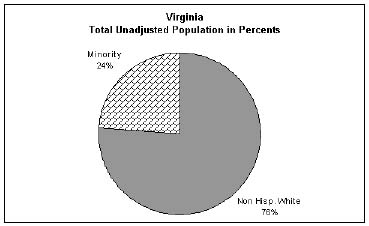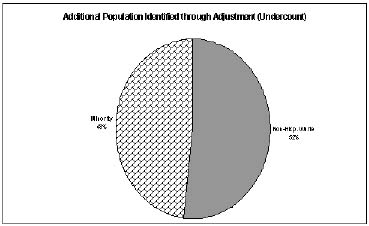State-by-State Analysis: Virginia
The
1990 undercount and its demographic composition
As
indicated in Table 1, the percentage undercount of 2.0 percent in Virginia
was higher than the national average of 1.6 percent and resulted in a net
numerical undercount of 126,478 persons, sixth highest in the nation. For
non-Hispanic whites, Table 1 indicates, the undercount percentage was 1.4
percent as compared to 4.0 percent for members of minority groups. As indicated
in Table 2 and the summary Chart below, these differentials between whites
and minorities resulted in an undercounted population with a much greater
minority group percentage than the state's total population. In Virginia,
non-Hispanic whites comprised 76 percent of the state's uncorrected population,
whereas members of all minority groups combined comprised 24 percent. In
contrast, non-Hispanic whites comprised 52 percent of the state's undercounted
population, whereas members of all minority groups comprised 48 percent.
In numerical terms, the undercount consisted of 66,312 non-Hispanic whites
and 60,166 members of minority groups. In Virginia, the minority population
consists primarily of non-Hispanic blacks. In Virginia, 78 percent of minority
group members are non-Hispanic blacks, 11 percent are Hispanic, and 11 percent
are members of other minority groups.


Implications
of 1990 Census adjustment for minority voter opportunities
Given
the dispersion of the undercount in Virginia and the configuration of legislative
districts, there do not appear to be any districts in this state with the
potential for a significantly enhanced minority population through the use
of corrected rather than uncorrected data for the post-1990 redistricting.





